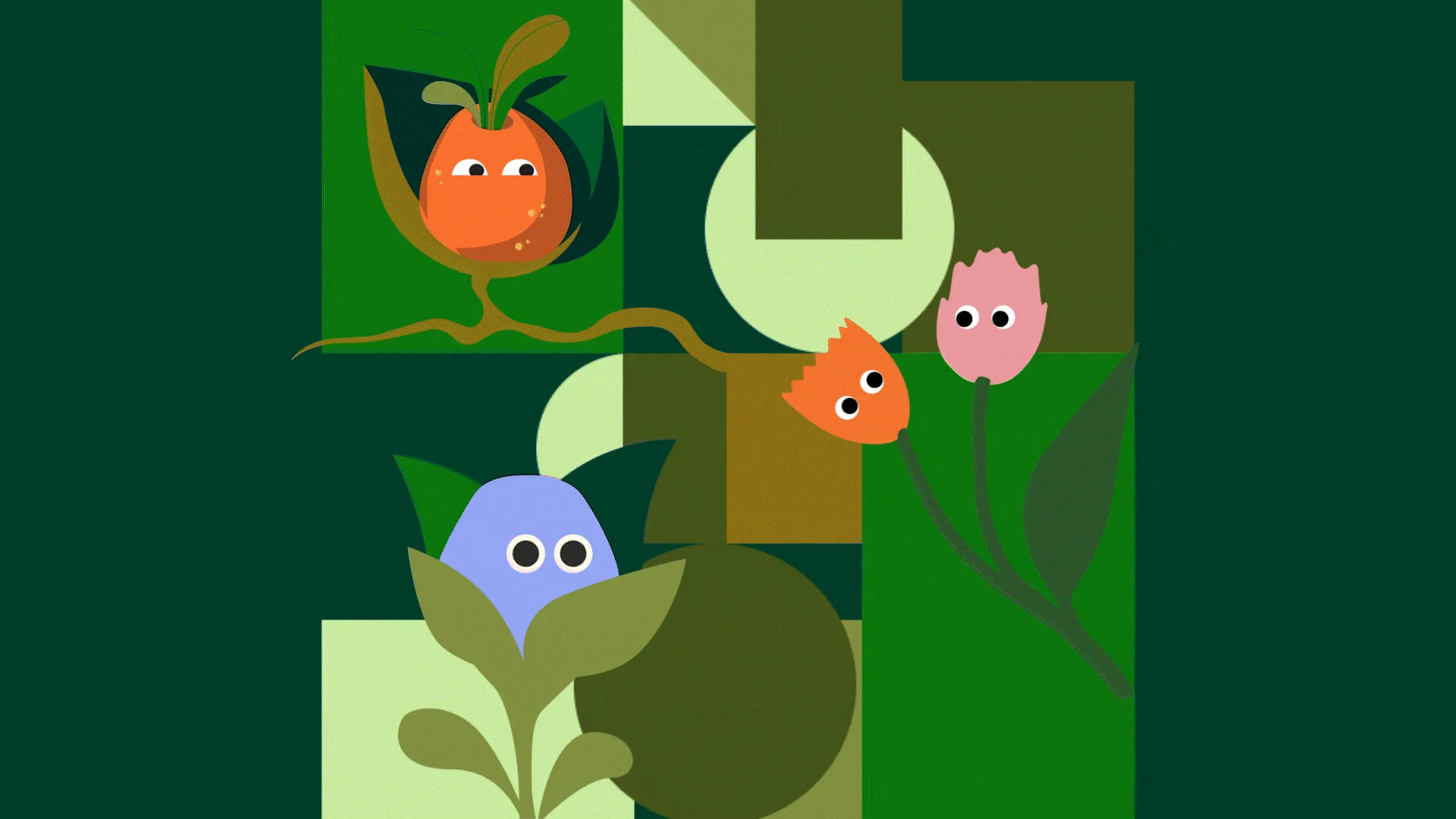The Idea Garden
From spark to fruition: your ideas, naturally cultivated
Winner—School Prize, FigBuild 2025
FigBuild 2025 was a country wide design competition where 250+ teams were challenged to reimagine problem-solving through a unique lens: What if you could gain any superpower to address a daily frustration, and what tool would you need to harness it effectively? Teams had one week to develop their concept using Figma. We chose to address the pain of lost ideas through 'Thought Crystallization'—the ability to transform mental sparks into persistent, growing entities.
Platform Figma, Adobe Illustrator, Adobe After Effects
Role Product Designer - Research, Concept Design, User Flow Design, Visual Design
Duration 3 day design sprint
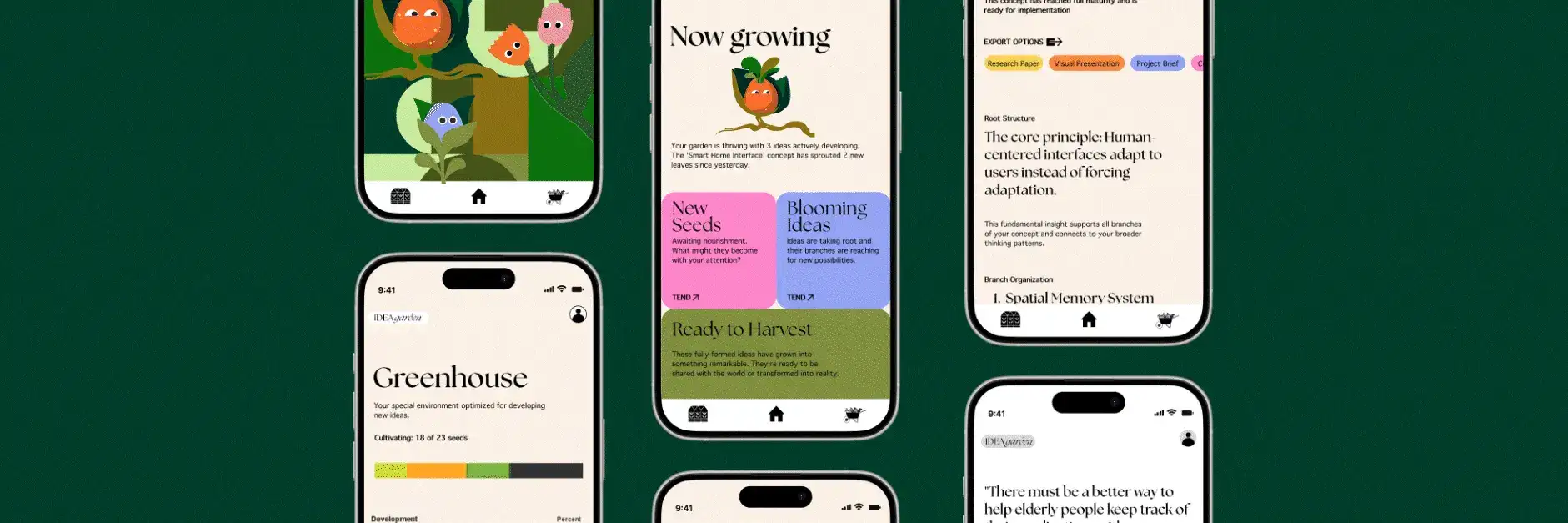
How many brilliant ideas have you lost forever?
That sudden inspiration in the shower, the perfect solution that comes just before sleep, or that creative breakthrough during your commute—all gone before you could fully develop them.
Problem Statement: Every day, our minds generate thousands of thoughts, but the most brilliant insights often disappear before we can develop them. We need a more intuitive way to capture, organize, and nurture our ideas over time.
Imagine instantly transforming any fleeting thought into a persistent, living seed
Imagine instantly transforming any fleeting thought into a persistent, living seed that grows as you nurture it. With this superpower, your ideas become tangible entities that evolve, branch out in new directions, and connect with related concepts organically.
The Idea Garden is a mobile app that transforms your ideas into living digital plants
The Idea Garden is a mobile app that transforms your ideas into living digital plants.
Capture
Every captured thought becomes a unique plant in your garden
Grow
Ideas grow and evolve whenever you engage with them
Connect
Related thoughts automatically connect through root systems
Develop
Different idea types develop distinct visual characteristics
Organize
The garden dynamically organizes itself based on idea relationships
Nine Stages of Natural Idea Development

While visiting his grandmother, Alex watches her juggle five different remotes and two smartphone apps just to watch TV and adjust the thermostat.
A thought forms: "Why can't smart home interfaces adapt to human routines instead of making humans adapt to them?"
Without any manual input, The Idea Garden captures this observation as a seed with unique characteristics reflecting its focus on human-centered design.
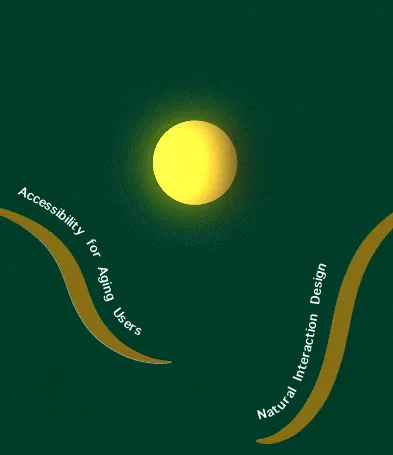
The next day, Alex watches children at a playground intuitively understanding how to use equipment without instructions.
This observation triggers a deeper insight: "The core issue is that current interfaces are device-centric, not human-centric."
This fundamental realization forms the tap root of Alex's idea plant. Remarkably, the app shows this root extending toward and connecting with two other existing plants in Alex's garden.
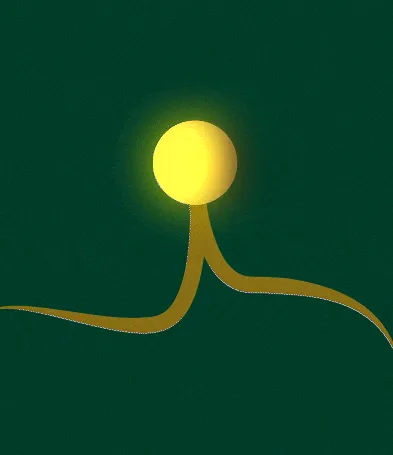
Throughout the week, Alex's superpower captures related observations:
- His roommate instinctively adjusting the shower temperature without looking
- A restaurant using spatial layout to guide customer behavior
- His own frustration trying to remember which app controls which light
Each observation automatically attaches to the root system, creating a rich network of supporting context. The app shows these roots connecting not just within this idea, but reaching toward other related plants in different areas of the garden.
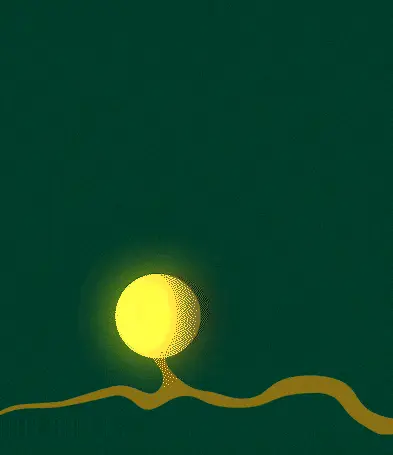
Two distinct experiences spawn new branches on Alex's idea plant:
- Visiting a museum with intuitive wayfinding inspires a "Spatial Memory System" branch
- Noticing how his coffee shop anticipates his order based on time of day creates a "Temporal Pattern" branch
Each real-world experience automatically generates a new direction for exploration without Alex needing to manually document anything.

When Alex mentions his idea to friends, their responses automatically generate new leaves:
- An architect friend suggests, "Think about how different rooms have natural functions"
- His grandmother points out, "I just want things to work without reading manuals"

Alex sketches a few concepts and shows them to potential users.
Their positive reactions and specific feedback cause the Spatial Memory branch to begin flowering.
This validation happens in natural contexts - showing sketches to his grandmother, discussing with roommates - and each interaction automatically strengthens the corresponding part of the plant.
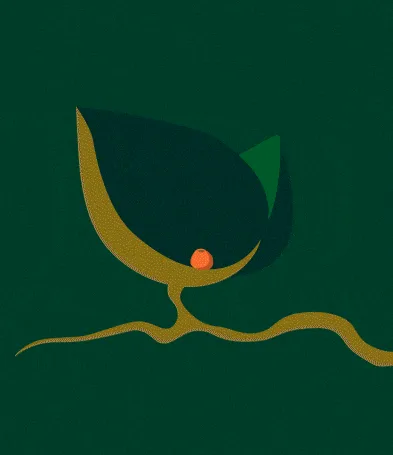
As Alex refines his concept through real-world testing and feedback, concrete outputs begin forming as fruits on the plant:
A working prototype appears as a large, central fruit
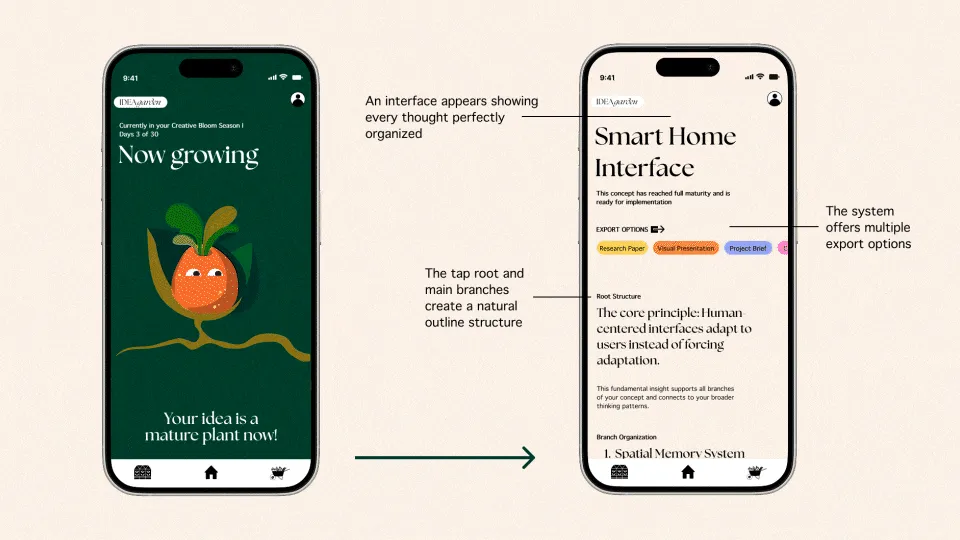
An interface appears showing every thought perfectly organized. The tap root and main branches create a natural outline structure. The system offers multiple export options.
Root Structure: The core principle: Human-centered interfaces adapt to users instead of forcing adaptation.
Branch Organization: 1. Spatial Memory System, 2. Temporal Pattern Recognition, 3. Contextual Awareness Layer
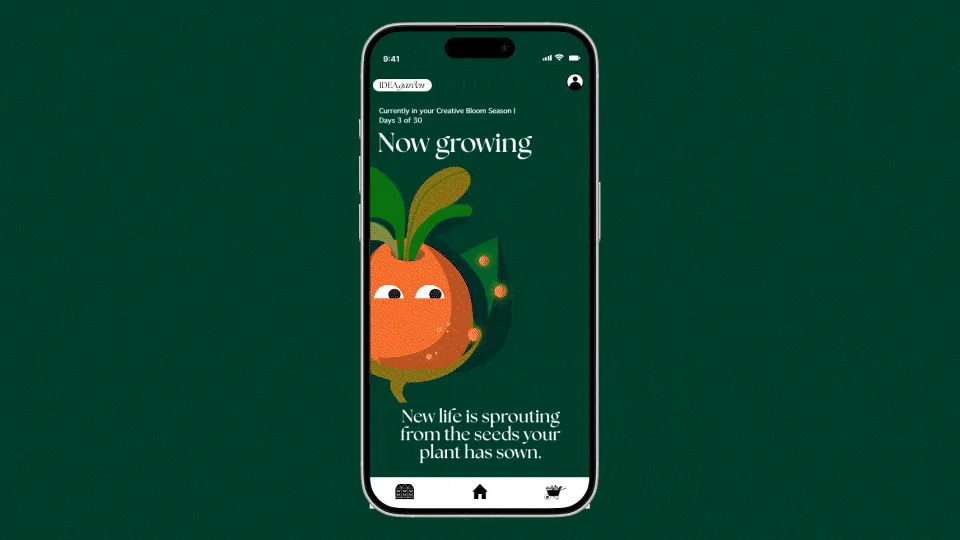
As Alex implements his smart home concept, new questions and possibilities emerge.
- "How might this approach work for public spaces?"
- "Could the same principles apply to professional software interfaces?"
These automatically form as seeds sprouting from the mature plant.
Problem-Solution Ideas
Fast-growing plants with practical fruits
Research Questions
Vine-like growth seeking connections
Creative Concepts
Colorful, wildflower-like growth with multiple blooms
Personal Projects
Sturdy plants with clear development stages
Beyond artificial folders and tags, ideas connect as plants in nature do—through natural, living networks
Inspired by Finding the Mother Tree: Discovering the Wisdom of the Forest, A Book by Suzanne Simard
Mycorrhizal Networks
Just as trees connect through fungal networks, your ideas automatically form meaningful relationships based on content, context, and usage patterns. These invisible threads allow thoughts to share resources and communicate with each other.
Mother Tree Hubs
Core concepts act as anchor points in your garden—like the elder trees in a forest that support the ecosystem. These foundational ideas nurture newer, related thoughts and maintain wisdom across your thinking landscape.
Resource Sharing
When you add information to one idea, related concepts automatically receive relevant "nutrients"—suggested connections, shared references, and contextual insights flow through the network.
Forest Succession
Watch as your garden undergoes natural evolution over time—early pioneer thoughts prepare the ground for more complex concepts, creating a living history of your thinking journey.
Powerful Gardening Tools
Idea Pollination:
Deliberately connect ideas to generate new insights
Collaborative Gardens:
Share specific plants or entire sections with others
Growth Analytics:
Understand your ideation patterns over time
Maintaining a Healthy Garden
CHALLENGE
Too many captured thoughts creating a cluttered garden
SOLUTION
Smart filtering and seasonal archiving
CHALLENGE
Initial thoughts that never develop
SOLUTION
Seed bank for revisiting potential later
CHALLENGE
Overwhelming connections between ideas
SOLUTION
Adjustable visualization levels for root complexity
Black Mirror Brainstorm
1.
People begin judging others by the "quality" of their idea gardens, creating a new form of intellectual discrimination
2.
The seamless capture feature leads to privacy issues when capturing thoughts in inappropriate contexts
3.
The automatic connections feature begins to influence how people think by subtly suggesting connections
4.
Companies begin monitoring employee idea gardens to identify who has "valuable thinking patterns"
Anti-Goals to Consider
- We must NOT design systems that create dependency by replacing natural cognitive functions
- We must NOT allow algorithm-driven connections to manipulate thought patterns
- We must NOT collect data in ways that could be exploited by employers or institutions
- We must ensure users maintain ownership and control of their thought patterns
- We must provide transparency about how the connection algorithms work
- We must include the ability to fully delete all data and "start fresh"
1.
Place your digital garden in physical spaces and walk through your ideas in full scale
2.
Use gesture controls for more intuitive interaction
3.
Create location-based idea zones (work garden, home garden, etc.)
4.
Share immersive idea presentations with others
Creative Professionals
Capturing Inspiration On-The-Go:
A graphic designer instantly saves visual concepts that appear throughout their day, watching them develop organically as they add sketches and references
Project Development:
An author nurtures a story concept from initial premise to fully developed narrative structure with character branches and plot roots
Knowledge Workers
Meeting Insights Management:
A product manager transforms scattered meeting notes into structured idea plants, with stakeholder input automatically organizing into appropriate branches
Research Organization:
A researcher builds an evolving knowledge garden where academic concepts connect through natural relationships rather than rigid citation hierarchies
Personal Development
Skill Learning:
A student creates an adaptive knowledge structure for a new subject, watching connections form naturally as they study related concepts
Habit Building:
A personal growth enthusiast tracks behavioral changes as growing plants, with progress visualized through healthier growth patterns
Teams & Collaboration
Distributed Ideation:
Remote teams contribute to shared idea gardens, watching concepts evolve across time zones through their collective nurturing
Innovation Tracking:
Organizations maintain living archives of innovations, preserving institutional knowledge as an ever-growing forest rather than static documents
- Moving beyond static note-taking to living, evolving thought systems
- Creating an emotional connection with our ideas through nurturing metaphors
- Building a more intuitive, visual language for tracking creative development
- Turning ideation from a momentary event to an ongoing relationship
